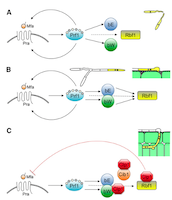Publication - Heimel et al. 2010b
The Ustilago maydis Clp1 Protein Orchestrates Pheromone and b-Dependent Signaling Pathways to Coordinate the Cell Cycle and Pathogenic Development. [Plant Cell. 2010 Aug 20. [Epub ahead of print]]
Heimel K, Scherer M, Schuler D, Kämper J.
Abstract
Regulation of the cell cycle and morphogenetic switching during pathogenic and sexual development in Ustilago maydis is orchestrated by a concerted action of the a and b mating-type loci. Activation of either mating-type locus triggers the G2 cell cycle arrest that is a prerequisite for the formation of the infectious dikaryon; this cell cycle arrest is released only after penetration of the host plant. Here, we show that bW, one of the two homeodomain transcription factors encoded by the b mating-type locus, and the zinc-finger transcription factor Rbf1, a master regulator for pathogenic development, interact with Clp1 (clampless 1), a protein required for the distribution of nuclei during cell division of the dikaryon. In addition, we identify Cib1, a previously undiscovered bZIP transcription factor required for pathogenic development, as a Clp1-interacting protein. Clp1 interaction with bW blocks b-dependent functions, such as the b-dependent G2 cell cycle arrest and dimorphic switching. The interaction of Clp1 with Rbf1 results in the repression of the a-dependent pheromone pathway, conjugation tube formation, and the a-induced G2 cell cycle arrest. The concerted interaction of Clp1 with Rbf1 and bW coordinates a- and b-dependent cell cycle control and ensures cell cycle release and progression at the onset of biotrophic development.


